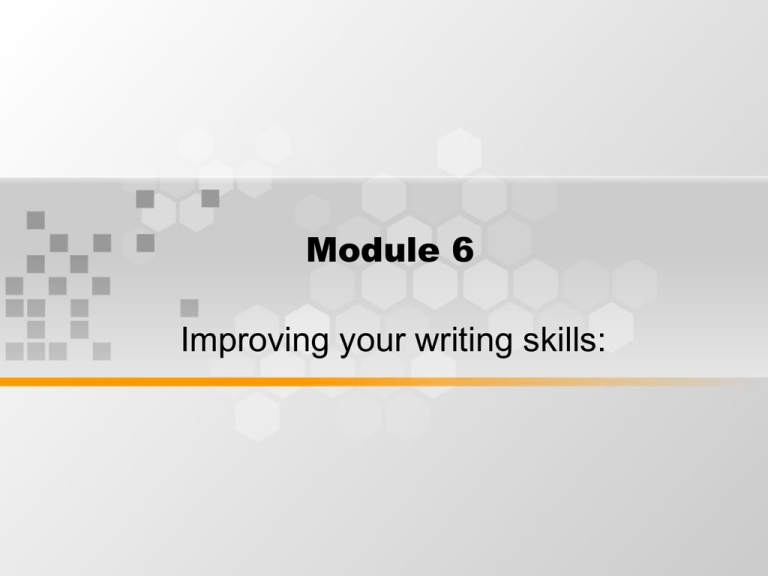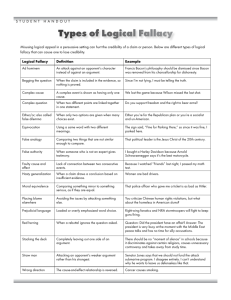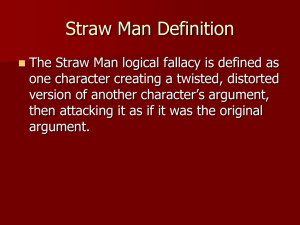Module 6 Improving your writing skills:
advertisement

Module 6 Improving your writing skills: What’s Inside • Making a research proposal • Critical Reading and Critical Writing • Effective review Style in Writing For Guide to Grammar and style, please refer to: http://newark.rutgers.edu/%7Ejlynch/Writing/contents.html Strunk and White’s: The Elements of Style http://www.bartleby.com/141/index.html Making a Research Proposal A.Substance • • • • • • • • Beware of the "straw man" argument Never say, "No one has ever looked at this, so I did..." Never say, "this is interesting" Never talk at the level of methods in your introduction (e.g., variables, measures, factors) Do not write papers for academics; better to write for your grandmother Introductions are the hardest to write: inverted triangle model: funnel Your study should be totally motivated from your introduction Avoid using the expression, "Research has found" or "studies have shown" (if you delete this, the sentence sounds much better) Making a Research Proposal B. Style • It is a fallacy that you should leave some obvious things wrong or incomplete in the paper so as to give the reviewer/reader something to criticize • Most people accept or reject a paper in the first 5 pages and then look for evidence in a confirmatory manner • Use active voice! • Edit! Edit! Edit! (e.g., cut all phrases such as, "in order to"; cut all boilerplate sentences (e.g., "in today's society") Making a Research Proposal C. Action items for you to take now • Write down every idea you have in a logbook or journal • Write every paper with the intention/expectation it will be published • Ask other people to read and comment upon your work (in return, you should do the same) • When you ask someone to read/comment or they ask you, ask for the date at which it will be no longer useful for them/you • Think in terms of always having 1 paper under review at all times • Think in terms of always working on at least 1 empirical (data) paper and at least one theory/conceptual paper at all times Straw man Argument A straw man argument is a logical fallacy based on misrepresentation of an opponent's position. To "set up a straw man" or "set up a straw-man argument" is to create a position that is easy to refute, then attribute that position to the opponent. A straw-man argument can be a successful rhetorical technique (that is, it may succeed in persuading people) but it is in fact misleading, since the argument actually presented by the opponent has not been refuted. • • • • • One can set up a straw man in the following ways: Present a misrepresentation of the opponent's position, refute it, and pretend that the opponent's actual position has been refuted. Present someone who defends a position poorly as the defender, refute that person's arguments, and pretend that every upholder of that position, and thus the position itself, has been defeated. Invent a fictitious persona with actions or beliefs that are criticized, and pretend that the person represents a group of whom the speaker is critical. Some logic textbooks define the straw man fallacy only as a misrepresented argument. It is now common, however, to use the term to refer to all of these tactics. The straw-man technique is also used as a form of media manipulation. Critical Reading Towards Critical Writing To read critically is to make judgments about how a text is argued. This is a highly reflective skill requiring you to "stand back" and gain some distance from the text you are reading. (You might have to read a text through once to get a basic grasp of content before you launch into an intensive critical reading.) THE KEY IS THIS: – don't read looking only or primarily for information – do read looking for ways of thinking about the subject matter Critical Reading Towards Critical Writing When you are reading, highlighting, or taking notes, avoid extracting and compiling lists of evidence, lists of facts and examples. Avoid approaching a text by asking "What information can I get out of it?" Rather ask "How does this text work? How is it argued? How is the evidence (the facts, examples, etc.) used and interpreted? How does the text reach its conclusions? Critical Reading Towards Critical Writing • Critical reading may involve evaluation. Your reading of a text is already critical if it accounts for and makes a series of judgments about how a text is argued. However, some essays may also require you to assess the strengths and weaknesses of an argument. If the argument is strong, why? Could it be better or differently supported? Are there gaps, leaps, or inconsistencies in the argument? Is the method of analysis problematic? Could the evidence be interpreted differently? Are the conclusions warranted by the evidence presented? What are the unargued assumptions? Are they problematic? What might an opposing argument be? How Do I Read Looking for Ways of Thinking? 1. First determine the central claims or purpose of the text (its thesis). A critical reading attempts to assess how these central claims are developed or argued. • Begin to make some judgments about context. - What audience is the text written for? - Who is it in dialogue with? (This will probably be other scholars or authors with differing viewpoints.) - In what historical context is it written? All these matters of context can contribute to your assessment of what is going on in a text. How Do I Read Looking for Ways of Thinking? 2. Distinguish the kinds of reasoning the text employs. - What concepts are defined and used? - Does the text appeal to a theory or theories? - Is any specific methodology laid out? - If there is an appeal to a particular concept, theory, or method, how is that concept, theory, or method then used to organize and interpret the data? You might also examine how the text is organized: - how has the author analyzed (broken down) the material? - Be aware that different disciplines (i.e. history, sociology, philosophy, biology) will have different ways of arguing. How Do I Read Looking for Ways of Thinking? 3. Examine the evidence (the supporting facts, examples, etc) the text employs. Supporting evidence is indispensable to an argument. Having worked through Steps 1-3, you are now in a position to grasp how the evidence is used to develop the argument and its controlling claims and concepts. Steps 1-3 allow you to see evidence in its context. Consider the kinds of evidence that are used. What counts as evidence in this argument? Is the evidence statistical? literary? historical? etc. From what sources is the evidence taken? Are these sources primary or secondary? Reviewing A. In general... • Don't be nasty or chastising (e.g., "the author is under a terrible misassumption…"; "the author failed…") • Imagine that you will be reading your review to the author in a face to face meeting • In general, do not criticize papers on the grounds of external validity (e.g., "does this generalize to all managers?") • Make 3-4 main points and then make a list of your small, picky items • A good written review is between 1-3 pages Things to look for: • • • • • • • • Is there theory in this paper? Or, is it a fishing expedition? Is there information gain from this paper or is it a conceptual replication? Obvious extension of theory? Are the results meaningful and worthwhile? Or so obvious as to be manipulation checks? Are the operationalizations true to the conceptual variable? Are there confounds? Are there any process measures to support what the authors believe are the psychology? Are there demand characteristics? Never say, this should be published or not, etc. (that is the editor's job) While Reviewing B. Morals and ethics • It is NOT appropriate to cite papers that you are reviewing • It is not cool to let someone know you are reviewing his/her paper at any time before or after, no matter what your current relationship with this person






